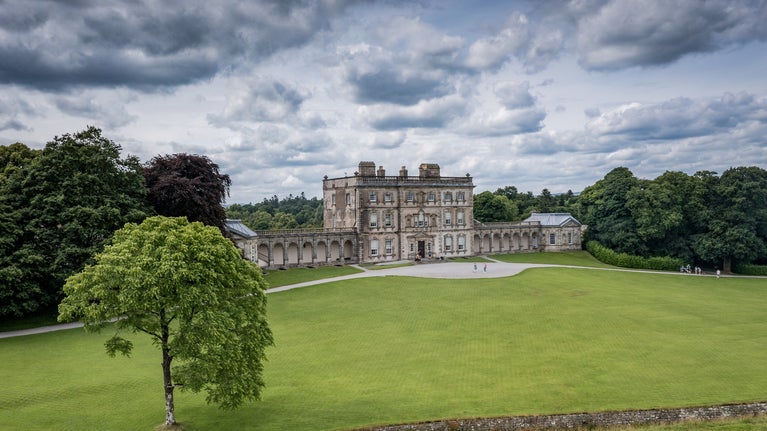
Discover more at Florence Court
Find out when Florence Court is open, how to get here, the things to see and do and more.

Florence Court is a fine example of the Irish country house, with a grand home surrounded by formal parkland and extensive woodlands. Today, the beauty and peacefulness of Florence Court bely the sometimes turbulent lives of those who lived and worked here during the course of its 300-year history.
Captain William Cole came to Ireland in 1601 as a professional soldier, serving under James I of England & 6 of Scotland.
James undertook a process known as the Plantation of Ulster, when much of the province was colonised by English and Scottish settlers loyal to the Crown, taking over lands forfeited from Irish families.
Enniskillen was founded as part of this settlement and Cole lived in Enniskillen Castle for a period, becoming the first Provost and then Governor of Enniskillen in 1617.
Florence Court, to the south west of Enniskillen, was home to the Cole family for over 250 years. A house was built here around 1720 by Sir John Cole, who named it after his beloved wife, Florence Bourchier Wrey. Their son, also named John, built the present house in the 1750s and the name Florence Court continued in memory of his mother.
The house was still unfinished at the time of young John’s death, and the colonnades and pavilions were completed by his son, William Willoughby Cole who became Earl of Enniskillen in 1789.
Through the 19th century the 3rd and 4th Earls of Enniskillen continued to develop the estate lands. William, the 3rd Earl, invested heavily in the estate and demesne and to support the local economy.
He built a pottery works which turned local clay into drainage pipes, bricks and tiles. The sawmill transformed trees into everything from coffins to fence posts, railway sleepers, furniture and gates.
William was also a keen palaeontologist, and gathered a large collection of fossil fish which he eventually sold to the British Museum. As Grand Master of the Orange Lodge of Ireland he was involved in many civic duties. William’s first wife, Jane Casamaijor, laid out the American garden with rhododendrons and azaleas on the sloping ground south of the house.

The house designer is a bit of a mystery. Several names have been proposed, including that of Davis Ducart, the architect or architects are unknown and in some of the main rooms superb decorative plasterwork survives, but there is no record of who the skilled plasterers were.
The central block mainly dates to the 1760s and its colonnades and wings to the 1770s. These hide extensive yards and service buildings, which were cleverly grouped around the back of the house and are virtually invisible from the front .
The landscape park was designed by William King in the late 1770s, who was one of the great landscape gardeners of the time. King planted belts of trees to provide shelter and woodland, and clumps of trees in open parkland where sheep, horses and cattle could graze. The mass of Benaughlin mountain provides a dramatic backdrop to the composition.
The walled garden at Florence Court was created during the late 18th century and substantial developments were later carried out in the late 1800s by the Head Gardener James Sutherland, working under the direction of Charlotte, wife of the 4th earl. During this period the rose garden was laid out beside the upper pond and a new approach to the garden was made via a wooden bridge with rustic palisades. Previously an arch made from whale jaw-bones had spanned this bridge.
The pergola in the lower garden with its climbing roses and clematis was also created at this time, (but re-created in the 1980s) as was a tennis court and plant nursery in the area to the north of the wall. Glasshouses were also constructed including the vinery and apricot house against the north wall. Their curvilinear central section was dismantled around the time of the First World War.
James Sutherland departed from Florence Court around 1908, after which the garden was run by a succession of head gardeners culminating with James Sheppard. Following his departure, the garden was gradually abandoned and by the 1960s it had become an overgrown wilderness.
A reconstruction of the garden’s layout and design in Sheppard’s time has shown that, in general, this garden was typical of traditional walled gardens, characterised by a mixture of flowers, fruit and vegetables grown in a formal ornamental plan.
At peak production, from the late 1890s up to the Second World War, 12 full-time gardeners would have worked in the kitchen garden. The produce from the garden provided valued harvests for the house and wider estate.

The demesne provided for the needs of the household with grazing for livestock and horses, a large deer park, arable land for crops and woodlands for timber. It was supported by income from the wider estate which, at its height, included nearly 30,000 acres of tenanted farmland, which provided much-needed rental income.
The latter part of the 19th century in Ireland was dominated by the Land Wars: a period of unrest and reappraisal of the historic form of land tenure and landlord- tenant relations. Like many others, Florence Court’s estate was significantly reduced by various Land Acts brought in by the British government around 1900 to address the situation. Consequently, many houses in Ireland lost their main source of income from tenanted land and began a gradual decline in fortune.
With the impact of the First and Second World Wars, rising taxes and the impact of death duties Florence Court eventually proved impossible for the family to maintain and the house was transferred to the National Trust in 1954.
After a devastating fire in 1955 the interiors of the house were quickly rebuilt and repaired. The contents had been on loan from the family and many had miraculously survived the fire. They were removed by the 6th Earl in the 1970s, when he and his wife went to live elsewhere but were generously returned by his widow, Nancy, in the 1990s. This breathed renewed life back into the house and the National Trust continues to restore the garden and demesne buildings so that future generations can enjoy this remarkable house, garden and demesne.

Find out when Florence Court is open, how to get here, the things to see and do and more.
Florence Court has plenty of opportunities for volunteering and we're always on the lookout for new additions to the team. Take a look at what it could involve.

Discover some of the conservation projects that have taken place at Florence Court in recent years, to help protect the place for everyone, for ever.
Take in sweeping vistas and elevated views on a walk through the estate, or wander through native woodland to spot historic features and the original Irish Yew tree.

Learn about people from the past, discover remarkable works of art and brush up on your knowledge of architecture and gardens.

From landscape gardeners to LGBTQ+ campaigners and suffragettes to famous writers, many people have had their impact on the places we care for. Discover their stories and the lasting legacies they’ve left behind.
